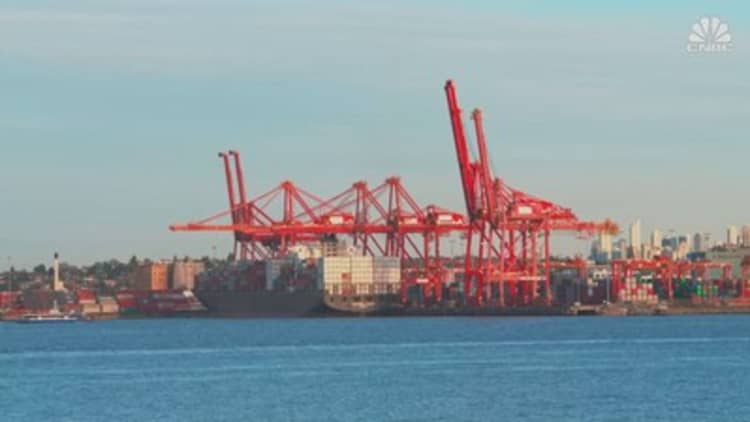
A container ship sits docked at the Port of Vancouver on November 20, 2021.
Justin Sullivan | Getty Images News | Getty Images
The BC Maritime Employers Association on Monday said collective bargaining is not progressing and said a “course change” is required.
The BCMEA, which represents port owners, said the International Longshore & Warehouse Union Canada’s Longshore Division “seems to have entrenched their positions,” rather than working for an equitable deal.
“The BCMEA has gone as far as possible on core issues,” the group said in a statement. “ILWU Canada needs to decide if they are going to continue this strike with no hope of settlement, or significantly modify their position so a fair and balanced deal can be reached.”
The employer’s comments come on the heels of calls for government intervention in the creation of back-to-work legislation.
When asked if the government is considering such a measure, the office of the Minister of Labor told CNBC: “We are not looking past the bargaining table, because the best deals are made at the table. Federal mediators continue to support the parties in their negotiations.”
Canadian Parliament is currently not in session and would have to be recalled, which would take several days. While remote voting is available, there would need to be a level of quorum in the room for the vote to happen.
ILWU Canada President Rob Ashton did not respond to CNBC’s request for comment by the time of publication.

The union’s U.S. West Coast chapter has supported their Canadian counterparts’ strike. President Willie Adams traveled to meet with Ashton on Monday. A photo on ILWU Canada’s Facebook page documented the meeting.
According to vessel data aggregated by MarineTraffic, a total of 24 vessels are carrying containers for the Ports of Vancouver and Prince Rupert. The value of the combined 181,458 containers floating off the ports of Vancouver and Prince Rupert reached $12 billion, based on a $65,225 value per container, and Canadian customs data.
The ILWU Canada division strike began Saturday. More than 99% of members of the union, which supports West Coast ports such as Vancouver and Prince Rupert, voted to approve the strike last month. Notice of the strike came Wednesday.
In a Facebook live comment Sunday evening, ILWU Canada President Rob Ashton made his case for a fair wage and the union’s willingness to stay at the table and negotiate.
“The ILWU Canada Longshore Division has not taken this decision lightly, but for the future of our workforce we had to take this step,” Ashton said in a post. “We are still hopeful a settlement will be reached through FREE Collective Bargaining!”
The union has been open to bargaining since February with the BCMEA and remains ready to continue working on a contract, Ashton added.

The two parties are at odds over issues including automation, the use of contract work and the cost of living for workers. Two mediators appointed by the Canadian government oversaw discussions that ran through the end of May. Those discussions were followed by a so-called cooling-off period between the two groups.
Industry followers warn that a strike in western ports around the holidays could hit the American economy. The Port of Vancouver and Port of Prince Rupert are popular destinations for U.S. trade, especially for goods arriving from Asia. Some logistics managers have told CNBC that rail service out of those ports is a lot faster than going through Seattle or Tacoma, Washington.
The International Longshoremen’s Association said it won’t take diverted cargo from ports with striking workers. The head of the International Longshore and Warehouse Union, which represents U.S. West Coast port workers, made a statement of solidarity with the Canadian union but did not mention any specific action.
The strike could lead to congestion in these ports with longshoremen unable to unload vessels. Congestion can turn into backlogs and lead to delayed pickups from terminals, which can then lead to late fees that are often passed on to consumers — similar to what occurred during the pandemic.
“ITS Logistics has significantly increased trucking capacity at all Chicago Area rail ramps to to move out as many containers as we can ahead of the container congestion we expect as a result of the strike,” said Paul Brashier, vice president of drayage and intermodal at ITS Logistics. “The strike is creating an artificial backup of containers which will create congestion once the containers are processed through the ports.”
The Canadian ports handle approximately $225 billion in cargo each year, with items spanning home goods, electronics and apparel transported by rail. Approximately 15% of consumer trade going through the Port of Vancouver is headed to or coming from the U.S., according to port authority data. Around two-thirds of containerized import volume going to the Port of Prince Rupert are headed to the U.S., port data shows.
Three Class 1 railways operate at these ports: CN, Canadian Pacific and BNSF, a subsidiary of Berkshire Hathaway
The American Apparel and Footwear Association and the National Retail Federation told CNBC they urge the Canadian government to help keep parties at the table. This strike is at the beginning of peak season when holiday and back-to-school items are coming in.
